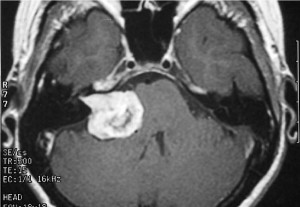If today’s young people don’t reduce their use of wireless mobile devices, they may suffer an “epidemic” of the disease in later life. Research indicates children and teenagers are five times more likely to get brain cancer if they use mobile phones.
At least nine out of ten 16-year-olds have their own handset, as do more than 40 percent of primary schoolchildren.
Many scientists have claimed that the wave of mobile communications made popular in the last two decades will result in long-term health implications worldwide. An unprecedented level and frequency of tumor growth inside the human brain may be inevitable.

Yet investigating dangers to the young were omitted from a massive investigation of the risks of cancer from using mobile phones, even though the official Mobile Telecommunications and Health Research (MTHR) Programme — which is conducting it — admits that the issue is of the “highest priority”.
Mobile phone owners were urged to limit their use after the World Health Organization admitted they may cause cancer.
Despite recommendations of an official report that the use of mobiles by children should be “minimized”, the Government has done almost nothing to discourage it.
Minister across Europe have been encouraged to bring in stricter limits for exposure to radiation from mobile and cordless phones, Wi-fi and other devices, partly because children are especially vulnerable to them. They are more at risk because their brains and nervous systems are still developing and because — since their heads are smaller and their skulls are thinner — the radiation penetrates deeper into their brains.
Neurosurgeon and researcher Dr. Leif Salford has conducted many studies on radio frequency radiation and its effects on the brain. Dr. Salford called the potential implications of some of his research “terrifying.” Some of the most concerning conclusions result from the fact that the weakest exposure levels to wireless radiation caused the greatest effect in causing the blood brain barrier to leak.
Since he began his line of research in 1988, Dr. Leif Salford and his colleagues at Lund University Hospital in Sweden has exposed over 1,600 experimental animals to low-level radiation. Their results were consistent and worrisome: radiation, including that from cell phones, caused the blood-brain barrier–the brain’s first line of defense against infections and toxic chemicals–to leak.
Swedish research reported at the first international conference on mobile phones and health stemmed from .further analysis of data from one of the biggest studies carried out into the risk that the radiation causes cancer, headed by Professor Lennart Hardell of the University Hospital in Orebro, Sweden. Professor Hardell told the conference — held at the Royal Society by the Radiation Research Trust — that “people who started mobile phone use before the age of 20″ had more than five-fold increase in glioma”, a cancer of the glial cells that support the central nervous system. The extra risk to young people of contracting the disease from using the cordless phone found in many homes was almost as great, at more than four times higher.

Those who started using mobiles young, he added, were also five times more likely to get acoustic neuromas, benign but often disabling tumors of the auditory nerve, which usually cause deafness.
By contrast, people who were in their twenties before using handsets were only 50 percent more likely to contract gliomas and just twice as likely to get acoustic neuromas.
Professor Hardell told the IoS: “This is a warning sign. It is very worrying. We should be taking precautions.” He believes that children under 12 should not use mobiles except in emergencies and that teenagers should use hands-free devices or headsets and concentrate on texting. At 20 the danger diminishes because then the brain is fully developed. Indeed, he admits, the hazard to children and teenagers may be greater even than his results suggest, because the results of his study do not show the effects of their using the phones for many years. Most cancers take decades to develop, longer than mobile phones have been on the market.
The research has shown that adults who have used the handsets for more than 10 years are much more likely to get gliomas and acoustic neuromas, but he said that there was not enough data to show how such relatively long-term use would increase the risk for those who had started young.
He wants more research to be done, but the risks to children will not be studied in the MTHR study, which will follow 90,000 people in Britain. Professor David Coggon, the chairman of the programmes management committee, said they had not been included because other research was being done on young people by a study at Sweden’s Kariolinska Institute.
He said: “It looks frightening to see a five-fold increase in cancer among people who started use in childhood,” but he said he “would be extremely surprised” if the risk was shown to be so high once all the evidence was in.
But David Carpenter, dean of the School of Public Health at the State University of NewYork — who also attended the conference — said: “Children are spending significant time on mobile phones. We may be facing a public health crisis in an epidemic of brain cancers as a result of mobile phone use.”
A scholarly article on cell phone safety published online in the journalElectromagnetic Biology and Medicine reported the finding that cell phones used in the shirt or pants pocket exceed the U.S. Federal Communications Commission (FCC) exposure guidelines and that children absorb twice as much microwave radiation from phones as do adults.
The paper notes that the industry-designed process for evaluating microwave radiation from phones results in children absorbing twice the cellphone radiation to their heads, up to triple in their brain’s hippocampus and hypothalamus, greater absorption in their eyes, and as much as 10 times more in their bone marrow when compared to adults.
Earlier research on pregnant mothers who use mobile phones has shown they are likely to give birth to kids with behavioural problems, especially if those children start using mobile phones early themselves.
Researchers from the National Institutes of Health have found that less than an hour of cellphone use can speed up brain activity in the area closest to the phone antenna, raising new questions about the health effects of low levels of radiation emitted from cellphones.
The study published in The Journal of the American Medical Association, is among the first and largest to document that the weak radio-frequency signals from cellphones have the potential to alter brain activity.
“The study is important because it documents that the human brain is sensitive to the electromagnetic radiation that is emitted by cellphones,” Dr. Volkow said. “It also highlights the importance of doing studies to address the question of whether there are — or are not — long-lasting consequences of repeated stimulation, of getting exposed over five, 10 or 15 years.”







